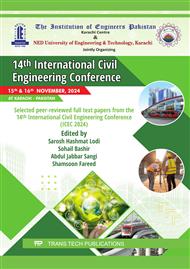p.127
p.139
p.149
p.157
p.165
p.173
p.181
p.191
p.205
Seismic Response of Structures Subjected to Pounding under Mainshock-Aftershock Sequences
Abstract:
During earthquakes, structures can collide with each other due to provision of very small or no gap between them. This collision can cause massive amount of damage and it can be a very critical issue for structures which get subjected to mainshock-aftershock sequence of significant magnitude. In the usual design practice of building structures, neither pounding nor aftershocks are considered. Therefore, in the current study, a detailed investigation of structures which can be commonly found in Karachi is performed when they are subjected to pounding under mainshock-aftershock sequences. To this end, a FEM model was developed and processed through nonlinear time-history analysis under natural and artificial mainshock-aftershock sequences. It was found that pounding under aftershocks can increase story shears up to 2.18 times and story drifts up to 1.46 times that in the absence of pounding. Results of this study also showed that during pounding under aftershock, structure is still subjected to similar amount of force as in mainshock, however it is already in a damaged state due to mainshock.
Info:
Periodical:
Pages:
165-171
Citation:
Online since:
April 2025
Authors:
Price:
Сopyright:
© 2025 Trans Tech Publications Ltd. All Rights Reserved
Share:
Citation:


